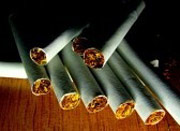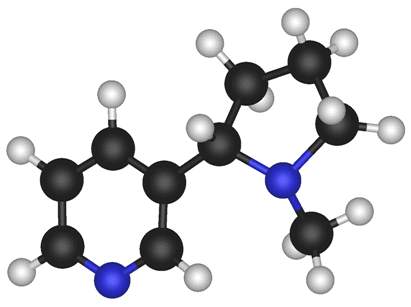
Tobacco (Nicotiana tabacum)
Have you ever consumed tobacco in the form of a cigar,
cigarette, chew, snuff, or pipe tobacco and wanted to know a
little more about the herb that you are consuming? Did you
ever think to start smoking to feel socially adjusted in the
group? There are many other reasons that people will start
smoking including viewing it as “the cool thing to do”, seeing
it in movies, wanting to look grown up, curbing their appetite,
oral fixation, and a feeling of relaxation. Please take a
look around my website and you may find some
interesting facts about tobacco that you may not have known
before.
General
Tobacco is an herb that is used widely among many people.
Tobacco's strict religious uses, including the healing of wounds and
the control of pain with smoke, have almost vanished and now tobacco
is used by millions of Americans everyday as a recreational drug.
The ingredient in tobacco that is addictive, keeping people wanting
more, is nicotine. Nicotine is an alkaloid, or poison,
which is naturally occurring in the plant. It is present in every
form of tobacco, some more concentrated than others.
When consumed, tobacco has both short term and lasting long-term
effects on the consumer. The short-term effects include an
increase in blood pressure, heart rate, and flow of blood away from
the heart. Some of the documented long-term effects it is known to
have include: chronic lung disease, coronary heart disease, and
stroke. Tobacco is also documented to cause cancer of the lungs,
larynx, esophagus, mouth, and bladder. Tobacco
is not only used for consumption but also can be used as an organic
pesticide. In the form of nicotine tartrate, tobacco can be
used in medicines.

Native Americans consumed tobacco orally in the
form of chew. This method of consumption works because the tissue
in your mouth is very thin and in close contact with your blood
vessels, allowing the nicotine to transfer from the plant and into
your blood stream. In today's world, bits of fiberglass have been
added to chew or “dip” in order to faster absorb the drug into the
system for a bigger “buzz”.
Industry
There are many different species of tobacco all under the genus
Nicotiana. The word nicotiana, as well as nicotine, was named in
honor of a French ambassador to Portugal named Jean Nicot. In 1559
she sent the plant
 tobacco
to the court of Catherine de' Medici as a medicine and it acquired
that name in honor of her ever since. Tobacco is harvested every
year and is cultivated similar to other crops in cold frames and
hotbeds in order to prevent insects from destroying them. Upon
harvesting, tobacco is then left to cure allowing the carotenoids in
the leaves to oxidize and degrade giving the smoke that “smooth”
property. The production of tobacco is huge in America with a
single machine making up to 3,000 cigarettes per day as early as
1881! Here in the United States, tobacco
is much more than just a plant. Tobacco employs up to 660,000
American workers providing $15 billion in wages to them.
tobacco
to the court of Catherine de' Medici as a medicine and it acquired
that name in honor of her ever since. Tobacco is harvested every
year and is cultivated similar to other crops in cold frames and
hotbeds in order to prevent insects from destroying them. Upon
harvesting, tobacco is then left to cure allowing the carotenoids in
the leaves to oxidize and degrade giving the smoke that “smooth”
property. The production of tobacco is huge in America with a
single machine making up to 3,000 cigarettes per day as early as
1881! Here in the United States, tobacco
is much more than just a plant. Tobacco employs up to 660,000
American workers providing $15 billion in wages to them.
Once this herb was newly discovered, the government did not waste
any time in getting their hands on such a growing and explosive
market. In Wisconsin today, each pack of cigarettes on average is taxed
$2.52. New York is the leader in the United States with a
cigarette tax of $4.35 a pack! Adding up all of the states combined, the average pack is
taxed $1.45 per pack.
Addiction
Why is tobacco so addictive?
Tobacco is addictive in a couple different ways. There is the
physical addiction and there is the psychosocial addiction.
The physical addiction affects the brain and does not develop
immediately. The addiction can take up to weeks or even months
to develop and it is known that people who begin smoking before the
age of 20 are more dependant on the addiction.
The psychosocial addiction is simply the fact that smoking gives
pleasure to some people. They enjoy handling the cigarette and
taking drags off of it. They use cigarettes for a quick fix in
times of discomfort and/or anxiety.
For more general information about tobacco, its production, and effects on the body, please visit tobacco-facts.net.
So now that you know a little about tobacco in general, let us take a look at how this herb is classified by clicking here.
If you are interested in researching other organisms like mine, you should check out the diverse collection found at MultipleOrganisms.net which my website is a part of!
If you would like to check out some very interesting fungi in the mean time make sure to check out my professor's (Dr. Volk) website by clicking here!
Organismal Biology, Logan Van Hoof, April 2011